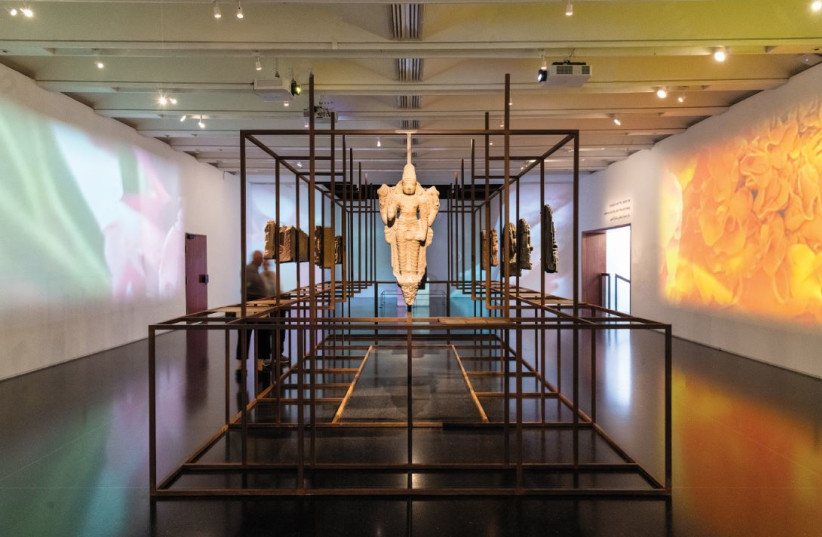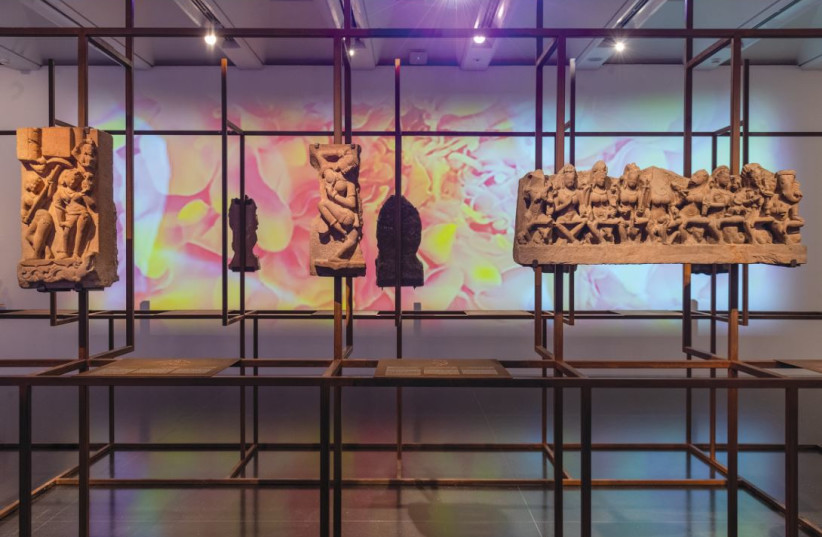There are art exhibitions that come with more than their fair share of PR packaging, bright lights, buzz-generating hullabaloo, razzmatazz and whatnot. One only has to think, for example, of someone like Chinese megastar artist Ai Weiwei or fabulously wealthy British counterpart Damien Hirst and the publicity maelstrom that inevitably comes with any showing of their work.
Then again, there are exhibitions that not only don’t get large-scale promotion, but they also don’t necessarily grab your eye as soon as you enter the display area.
“Body of Faith,” which opened last month at the Israel Museum under the curatorship of Miriam Malachi, may not follow the flashing-lights route or exude the immediately compelling ambiance you might associate with events that deserve a slice or two of your time and attention. However, should you decide to tarry at the layout of ancient sculpture, there is a good chance you’ll find yourself thoroughly absorbed.
What is on display at the Body of Faith exhibit at the Israel Museum?
There are 14 sculptures of deities in the show, which features divine characters that are important to the 4,000-year-old Hindu belief system. While some of the attributes and motifs may not immediately ring a bell, there is plenty to see and ponder.
For most of us, a little background knowledge would not be out of place. The exhibits, the majority of which were sent over from New Delhi’s National Museum of India, include eight on display outside India for the first time. They exemplify the religious art and immensely diverse philosophy that developed on the subcontinent between the fourth and 13th centuries CE, when the great dynasties of the Gupta, Chola and Pala kings ruled the roost.

This passage of history also saw the consolidation of the many forms of worship – or puja – that confer well-being and spiritual meaning on the faithful and take place everywhere, at all times, in an endless number of shapes and traditions.
Hinduism appears to take a pretty accommodating approach to devotion. Practitioners or religious communities are able to pray to any god however they see fit, and even create new objects of worship that cater to a specific need, such as a rare illness that has plagued a village or a local ecological catastrophe. Once petitioned, the gods are obliged to respond, lest they violate the dharma – the cosmic order.
And there are corporeal matters to take on board. For anyone – such as the vast majority in this country – who has grown up with monotheistic belief, a divine being having more than the expected complement of arms and heads, not to mention two genders, is probably a challenging idea.
It is not just looking at physical depictions of deities. There is the additional idea of viewing a pantheon of heavenly characters rather than a single omnipotent entity. Malachi is keenly aware of the challenge some visitors may have before they can allow themselves to view the exhibits.
“I thought about how to address all this so that people won’t be afraid of this in terms of idol worship. It is a subject that prompts antagonism. I come from a haredi family, and that was a major consideration of our everyday life.”
Miriam Malachi
“I thought about how to address all this so that people won’t be afraid of this in terms of idol worship. It is a subject that prompts antagonism. I come from a haredi family, and that was a major consideration of our everyday life,” she says.
On a purely anatomical level, we are presented with a physiological conundrum when we view an 11th-century basalt carving from southern India. We are told that Brahma, the creator of the world, is a member of the Hindu divine trinity, or trimurti, together with Vishnu and Shiva. They collectively comprise a seemingly diametrically contrasting bunch of creator, preserver and destroyer. All bases are duly covered.
The sculpture has three heads. Hindu legend has it that while Brahma dreamed of the creation of the world, he achieved such an intense degree of meditation that his body split into two. One remained male, while the other became female and took the name of Brahmani.
It certainly helps to get some sort of handle on Hindu traditions and faiths but, presumably, most visitors are not going to spend time steeping themselves in the backdrop to the material representation of ancient Indian beliefs before they pop over to the museum. Not to worry, there is plenty in the way of pure aesthetics to be enjoyed in “Body of Faith,” too.
AS WITH many other cultural projects of late, this exhibition traversed a pandemic-impacted logistically rocky road before it eventually came to fruition. The original plan was also to run the show last year, referencing the 75th anniversary of India’s independence from the British Raj. Then again – as we are tuning up for our own three-quarter century rebirth and separation from British rule milestone, and the exhibition just managing to open before 2022 ended – the timing seems binationally appropriate after all.
The project was also something of a slow burner. “Initially, we thought we’d only get one work from India, and then they suggested more,” Malachi explains. Matters began to gather pace. “The Indian embassy got involved, and our Foreign Ministry, and [President Isaac] Herzog attended the opening,” she adds. “It worked out to be something very special.”
Malachi has done her best to generate a sense of the cultural ambiance for those who have not been to India and caught, firsthand, some of the religious rites practiced by hundreds of millions of Hindus there on a daily basis. Before getting close to the sculptures, watch a video clip from a Hindu temple in southern India. It not only shows some of the ceremonial customs but also conveys the sumptuous aesthetics that go with religious observance.
The temple is clearly well supported financially, and very far from the modest material circumstances – in Western terms – in which many Indians live. But then, as anyone who has been over to the subcontinent will no doubt have learned, the concept of what constitutes a fulfilling and happy life is very different over there.
“By highlighting the significance of these sculptural masterpieces and the myths associated with them, the exhibition will offer the Israeli public a close-up look of some of the most famous cultural gems from India and will enable us to achieve a more meaningful understanding of the role of deity in Indian society,” Malachi states, adding that the place of worship in question attracts over 100,000 devotees every day.
To Western eyes, especially if we have seen images of Indians begging in the streets and sleeping rough, the opulence of the interior décor where the video was shot may seem more than a little incongruous, if not downright socially unjust, compared with the reality of everyday life there. Malachi, however, points out that this is not a matter of the local religious affairs government authority doling out hard-earned taxpayers’ cash as they see fit, with no regard for existential challenges.

“We should remember that these temples are supported by the public, not by the state. And they are located in enormous compounds. There is state support for preserving the buildings, and there is funding for all sorts of foundations. But the idea is that these places are owned by the religious believers themselves. It is an interesting operational model, a bit like synagogues here.” An interesting point.
Once we have absorbed a little of the religious rites environment we will, hopefully, be more receptive to some of the ideas behind the intricate sculptural ornamental detail.
Presuming the visitor spends more than the obligatory minute or two with each work, that should work well. The curator also took into account the popularity of India as a travel destination for many Israelis as a post-IDF jaunt or for older folk possibly looking for some latter-day personal epiphany.
“For countless people who have been to India and encountered the roots of Indian culture and mythology, the exhibition is an enchanting opportunity to feel the wonders of this amazing subcontinent one more time,” the curator suggests.
That may very well be the case. My only trip to India was more than 30 years ago, but I duly found myself slipping into nostalgia mode and reliving the powerful sense of tradition and spirituality I felt there, literally, as soon as I set foot outside the airport building.
POSSIBLY THE most captivating exhibit, with its own spotlit berth, is the bronze portrayal of Shiva. The deity pertains to the very roots of Indian civilization, as far back as 3000 BCE. Although this scale of work probably requires quite a few well-built men to shift it, such sculptures had pride of place in religious processions. And it is a remarkable creation to behold. There are numerous aesthetic elements to be scrutinized and marveled at.
Take, for example, the figure’s swirling braided hair. The sense of dynamic motion is enhanced by the nifty rotational dance move as the four arms shoot off every which way, while the hands and fingers shape different forms of classical dance gestures. Flames leap out of the circular frame, and Shiva does his merry dance with a facial expression of something between pure bliss and tranquility, while trampling a forlorn-looking chap. “That’s an evildoer,” Malachi laughs.
Some of us may, at least, have heard the names of Shiva, Brahma and Vishnu, but probably only the Indian cultural cognoscenti know anything of some of the other deities, such as Surya, the sun god. “Body of Faith” provides a fun and alluring opportunity to learn something about the less familiar divine beings.
Surya is exhibited in the form of a high-relief arrangement dating to the eighth to ninth centuries. The fact that it is fashioned out of basalt is also noteworthy. The volcanic rock is particularly dense and unpliable, and it must have taken quite a while to achieve the decorative end result. And a fetching bottom line it is too, with Surya in the center flanked by a couple of smaller figures, spiced up with all kinds of ornamental motifs.
Surya is one of the primeval gods, and sun worshipers of yore saw him as the world’s creator and regenerator of life. North Indian kings of the time associated their dynastic origins with Surya.
“People don’t really know Surya,” says Malachi. “He is the enlightening force, the force that enables things to grow.” As with all the sculptures, the god’s attributes are symbolized by various elements, such as blossoming lotus flowers. The latter reference the god’s regenerative powers.
Interestingly, the figures wear boots, unlike the vast majority of godly characters in Indian traditional art who are barefoot. That was not a sign of social inferiority or lack of wherewithal. “Kings and gods went barefoot,” Malachi notes. “It was natural. It connected them with the ground.”
The footwear suggests cross-cultural influences of the day. “They were equestrians,” says the curator. “That comes from the believers in Zoroastrianism from Persia.” The god also sports the yajnopavita, or sacred thread of knowledge; and the two smaller attendants, Danda and Pingala, represent the physical power of war and the intellectual prowess inherent in the art of diplomacy.
In addition to the eye-catching aesthetics of the sculptures, the yin-yang substratum to many of the deities is intriguing and leaves one with food for thought. Perhaps a – return – visit to India is in order. ❖
‘Body of Faith’ closes on June 10. For more information: www.imj.org.il/en
